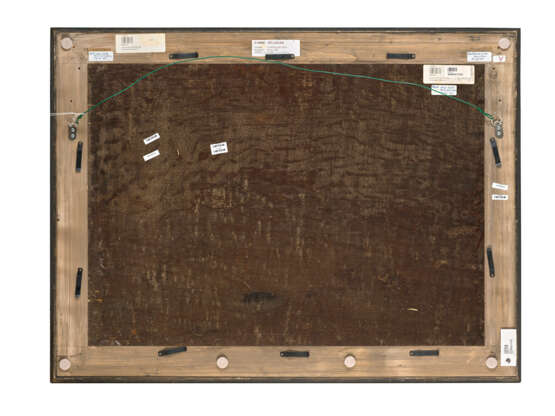ID 1336081
Lot 19 | LUCAS LUCE (ANVERS 1575 / 1576-1677 AMSTERDAM)
Estimate value
€ 80 000 – 120 000
Nature morte aux poires, pommes, raisins, noisettes et autres fruits, au roemer, au pichet en porcelaine et au verre façon-de-Venise sur un entablement en bois
signé et daté 'Lucas luce fecit an 16[...]4' (en bas, au centre) et 'LVCAS LVCE FESIT / 16(2?)4' (en haut, à gauche)
huile sur panneau
57 x 80,5 cm (22 7/16 x 31 11/16 in.)
Provenance
Chez Jacques Leegenhoek, Paris, en 2009 (selon le RKD — Nederlands Instituut voor Kunstgeschiedenis).
Vente anonyme, Sotheby's, New York, 31 janvier 2013, lot 152.
Chez Galerie Sanct Lucas, Vienne (selon une étiquette au revers du cadre).
Collection particulière, Belgique.
Further details
LUCAS LUCE (1575 / 1576-1677), STILL LIFE WITH PEARS, APPLES, GRAPES, HAZELNUTS AND OTHER FRUITS, A ROEMER, A PORCELAIN PITCHER AND A FAÇON-DE-VENISE GLASS ON A WOODEN LEDGE, OIL ON PANEL, SIGNED AND DATED
We know very little about the life of the Dutch artist Lucas Luce (1575/1576-1677). His date of birth was established on the basis of a document signed by the artist in 1648, in which he declared that he was around seventy-three years old. The son of an Antwerp merchant, he married Lysbet Willems van Rhenen in 1598, a cousin of the painter Joachim Wtewael (1566-1638). We also know that he was in contact with the painters Adam Willaerts (1577-1664), Joost Cornelisz. Droochsloot (1586-1666) and Balthasar van der Ast (1593-1657) in 1629, because he sold them houses in Utrecht. It is possible that it was as an art dealer that he forged these relationships with other players in the artistic milieu of his time, since many documents tell us of his mercantile activities. However, the quality of this painting also reveals someone who would have been recognised by his peers as a skilled painter, all the more so as he did not restrict himself to a single genre, his work also including portraits and genre scenes.
This varied composition with its vertiginous perspective suggests the influence of the Antwerp painter Osias Beert the Elder (circa 1580-1623). Like him, Luce offers the viewer a refined range of diverse elements set on a wooden table. By using several layers of very fine glazes, he achieves a great variety of colours, and captures the subtlety of light in the reflections of the glass, the lid of the jug and the waxy apple skin. However, the aim in such a composition was not to create an internal rhythm as such, but to play on the alternation of items and empty space, lending each object a greater independent weight.
Luce’s painting, following the artistic traditions of his day, offers two distinct symbolic readings to the viewer. The first, and that which is perhaps less evident to the modern eye, is the religious symbolism. The artist includes a butterfly and a caterpillar on the vine leaf at the bottom right, elements swiftly understood in the Seventeenth Century as a reference to the resurrection of Christ and to Holy Communion. The caterpillar symbolises Jesus made man, who passes through the chrysalis, representing the tomb, before finally ascending, like a butterfly, towards God in Heaven. The grapes, less enigmatic, are the basis of the wine that Jesus gives to his disciples at the Last Supper. The second, more obvious reading of the various elements relates to the prosperity of the United Provinces, gained despite its small territory and population size thanks to a worldwide network of maritime trade routes. Here we see the Venetian glass made on the island of Murano, in the lagoon of the Serenissima, and the Chinese porcelain pitcher decorated with exotic birds, which would have been exported by the Dutch East India Company from China to Amsterdam.
| Artist: | Lucas Luce (1575 - 1677) |
|---|---|
| Applied technique: | Oil on panel |
| Art style: | Old Masters |
| Genre: | Still life |
| Place of origin: | Belgium, Western Europe, Europe |
| Auction house category: | Paintings, Watercolors, Drawings, Paintings |
| Artist: | Lucas Luce (1575 - 1677) |
|---|---|
| Applied technique: | Oil on panel |
| Art style: | Old Masters |
| Genre: | Still life |
| Place of origin: | Belgium, Western Europe, Europe |
| Auction house category: | Paintings, Watercolors, Drawings, Paintings |
| Address of auction |
CHRISTIE'S 8 King Street, St. James's SW1Y 6QT London United Kingdom | |
|---|---|---|
| Preview |
| |
| Phone | +44 (0)20 7839 9060 | |
| Buyer Premium | see on Website | |
| Conditions of purchase | Conditions of purchase |





